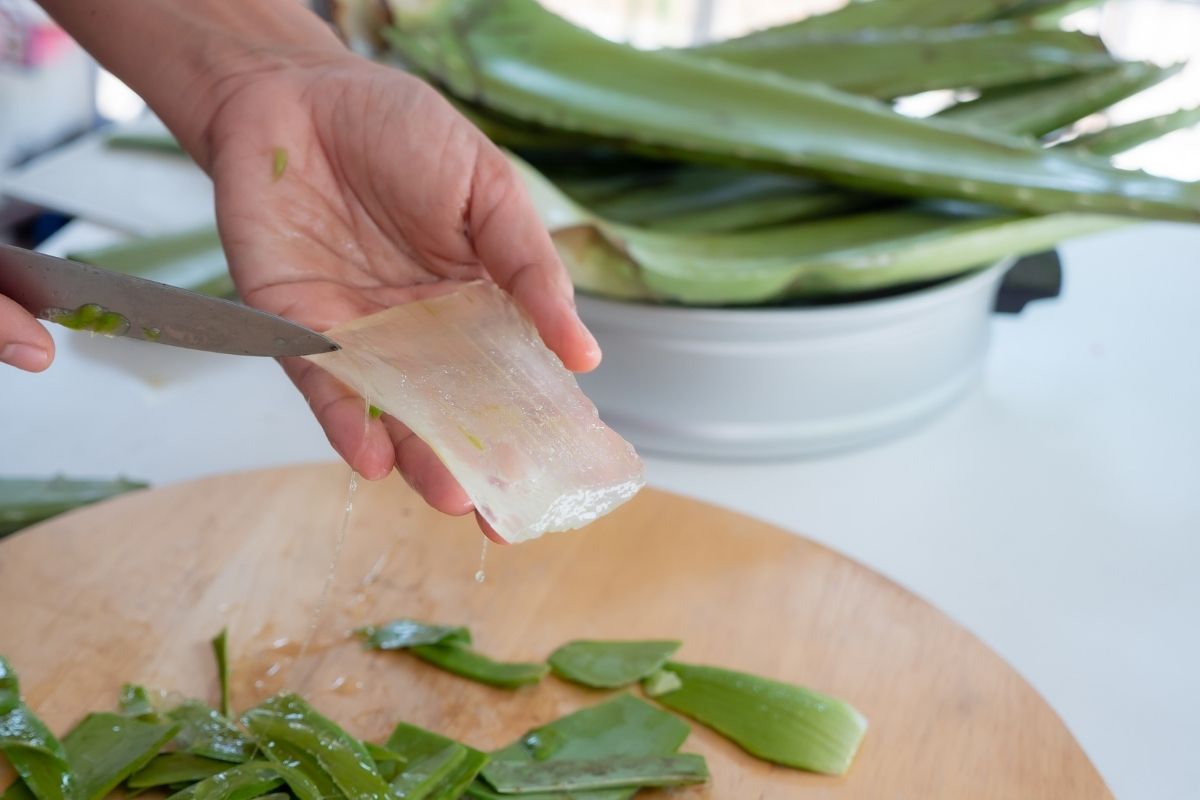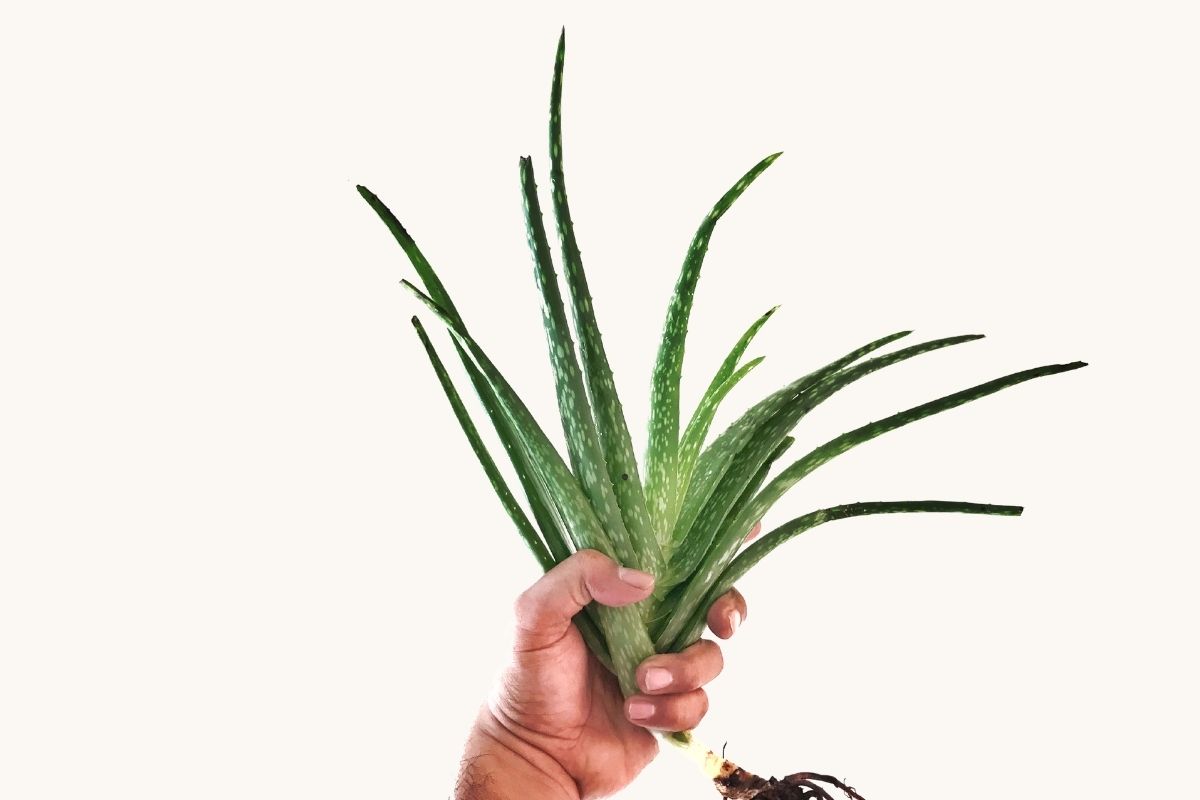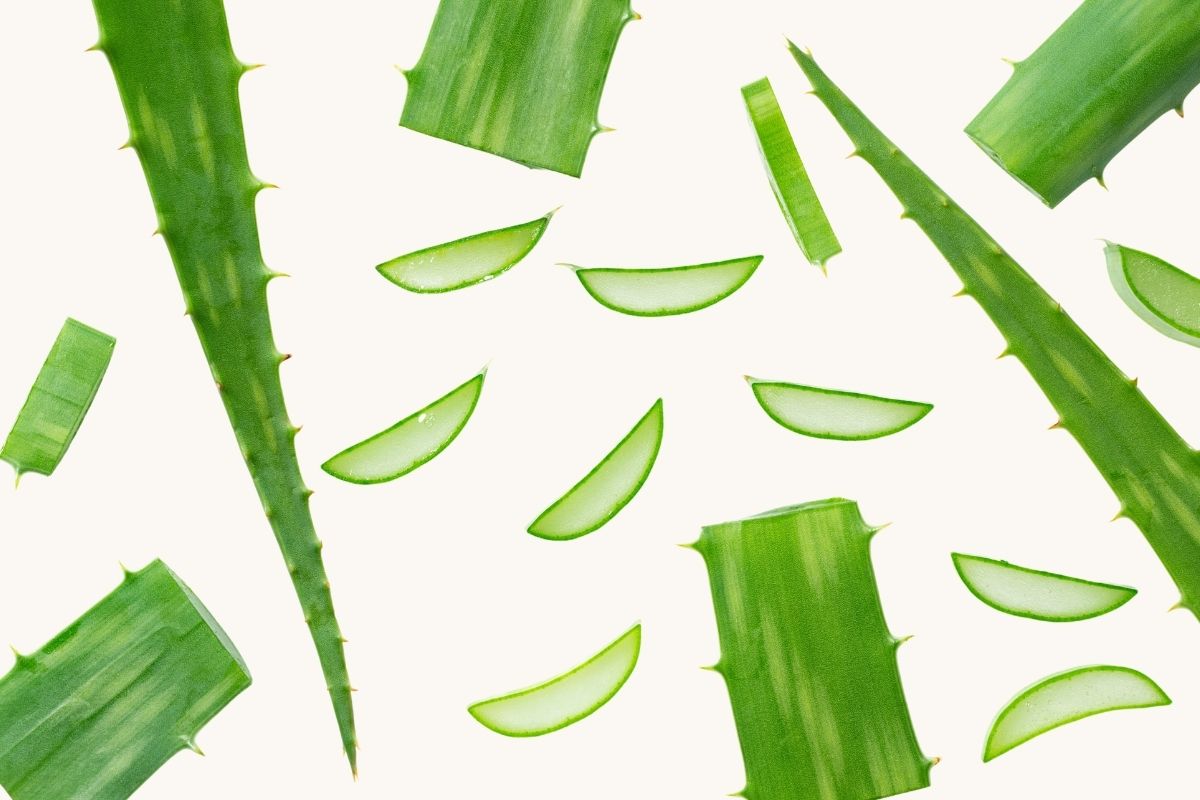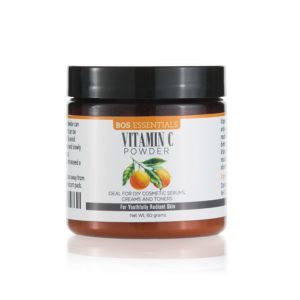Aloe vera plants are one of the most incredible and versatile plants you can have around your house or garden. This magical succulent plant with serrated edges and white spots is so practical and useful to have for cuts, scrapes and sunburns and even more.
The benefits of having your own fresh aloe vera gel at your fingertips are numerous, but first things first! It’s super important to know how to cut aloe vera plants without killing them to unlock their magical healing power without doing damage to the plant.
In this article, we’ll walk you through how to do it.
Harvesting aloe vera
The supplies you will need are:
- Scissors or a sharp garden knife
- A cutting board
- A small bowl with water
- Jar with a lid
Mature aloe vera plant with thick, healthy leaves (if you have a droopy aloe plant, hold off on harvesting the leaves until its perky again)
We like this aloe vera plant pack on Amazon. 😉

Instructions
- Choose a healthy looking aloe vera plant leaf from a mature plant. It is best to cut as close to the stem as possibly, to keep your aloe plant looking good. Most of the nutrients are stored in the stem, so it is important to carefully cut the leaf.
- After cutting the plant’s main stem, you will want to hold it over a small bowl with water to let the yellowish sap drip out. This yellow latex from the plant can cause irritation if it comes in contact with the skin, and cause diarrhea if ingested by accident.
- When the yellow sap is completely gone, give it a quick rinse in the bowl of water.
- Then, lay the entire leaf on a cutting board and use a serrated knife to remove the top piece of skin. To remove the bottom piece of skin, just flip the leaf over. Compost the cut part back to the earth.
- Now you will have the juiciest part leftover, the fresh aloe vera gel. You can apply the gel directly on your skin if you have any cuts, wounds or minor burns for instant relief. Or you can add the aloe gel to your fruit smoothie or drink. It is great to drink aloe vera gel daily for your overall health.
- If you have any leftover aloe vera gel that you want to save for later, it is highly recommended to put it in the refrigerator or freezer. In the fridge it can stay fresh for up to two weeks–and in the freezer it should last longer.
How to make aloe vera gel
Aloe vera gel is super beneficial for cuts, wounds, sunburns and bug bites. It has highly moisturizing qualities that you can also use on your face, hair and body.
Store-bought aloe vera contains many harmful, toxic ingredients with additives instead of pure aloe vera extract. It is much better and will benefit you to learn how to harvest and produce your very own aloe vera gel.
As we explained above, you just cut the aloe vera leaf and let the yellow sap drain. Once you peel the skin from the aloe vera, and have only the gel leftover you can add it to a blender and blend until it is frothy and more liquid. Unless you plan to use the gel right away, you can add vitamin E and vitamin C to preserve it.
You can freeze small amounts of aloe vera gel and keep it in the freezer for about two months.
To use the gel on your face or skin, wash your hands and rub the gel on the affected areas. You can leave it on to dry and wash clear gel off your skin when you feel you have received all the healing benefits.
This magic, soothing and healing gel can be used both internally and externally.
Benefits and uses of aloe vera:
Healthline has a great review of the benefits and uses of aloe vera, which are summarized here:
- helps with eczema and psoriasis
- provides heartburn relief
- moisturizing for face and hair
- anti-bacterial for minor wounds
- gets rid of ringworm and cysts
- used as a natural laxative
- helps to relieve insect bites, poison oak, poison ivy and mild cuts
- helps to heal cold sores & mouth sores (can be an alternative to mouthwash)
- helps to heal wounds & sunburns
- aids in weight loss
- it is an adaptogen for the body and alkalizes the body boosting the immune system
- detoxifies the body and supports kidney health
- hydrates and soothes the body
- has anti-bacterial and anti-fungal properties
- reduces high blood pressure and lowers blood sugar
- balances digestion and protects your immune system against infections
There are many different types of aloe vera plants, each with its own unique characteristics and benefits. The most common type of aloe vera is Aloe barbadensis, which is used for its medicinal properties and is safe for consumption.
Other varieties of aloe vera, such as Aloe ferox, Aloe africana, and Aloe arborescens, also have medicinal benefits but may not be safe to consume in large quantities.
Some species of aloe vera, such as Aloe vera var. chinensis and Aloe vera var. nobilis, are grown for ornamental purposes and do not have the same therapeutic properties as Aloe barbadensis.
Aloe vera propagation and care
You can definitely grow an aloe vera plant from a leaf cutting, but the most efficient way is propagating the plant from “pups” which will grow a new plant almost immediately. Although aloe vera are related to cacti, they hold a high moisture and water content, making it more difficult to propagate from just a whole leaf cutting.
Aloe vera cuttings are not the most reliable way to propagate a plant, but with offsets you have a good chance of growing a new plant.
Rooting aloe vera cuttings and separating aloe pups
Aloe pulps are also known as aloe offsets, they are baby plants that share the same root system as older leaves of the mother plant. To remove it from the mother plant you need to wait until it is about one-fifth the size of the mother plant. Another way you can tell it is ready is if there are already a few leaves.
The pups must have at least three mature leaves to be able to sustain itself and give nutrients to the plant. Only then will the rooting be successful.

To separate an aloe pup, remove the soil from the base of the pup. Use a sharp, clean knife to separate the pup from the mother plant. It should already be attached to its own complete root system.
If the plant does not come out easily because the root system has already grown so much it is tangled, just use a normal knife around the sides of the pot to loosen the roots. It is really important that your knife is clean to prevent diseases from transferring to the aloe pup.
Plant the freshly removed pup into a pot with a succulent potting mix or make your own with one part potting soil and one part sand. Let it sit for one week then add water to the new soil.
Propagating aloe vera requires a lot of patience, but after you can care for it like a normal aloe vera plant. Make sure your plant gets enough sunlight and water (overwatering will lead to root rot), and be sure to give it lots of love!
How to plant aloe vera plant without roots
Guess what, you can absolutely plant and propagate aloe vera without roots!
Follow the same steps above, of separating an aloe pup from younger leaves of the mother plant. Use a potting mixture that allows for good drainage. Dip the cutting in cinnamon or honey (these are natural rooting hormones which will help the roots develop) and plant the cutting into the soil.
Why doesn’t my aloe vera have roots?
Your aloe vera might not have roots because it was overwatered, or the soil did not drain well enough which in turn suffocates the plant. Experts say to water your aloe vera plant once a week, since they originally grow in more arid and dry climates.
It is also possible that your plant developed a disease of fungus, which in this case you can make a mix of charcoal, cinnamon, and chamomile to put on the bottom of the plant. Lastly, different pests can also affect the roots.
Aloe vera FAQs
How do you cut an aloe vera plant without killing it?
If you are using your aloe vera plant for medicinal use it is very important to know how to cut an aloe vera plant correctly. The aloe leaves are strong, but an incorrect trimming can end up damaging the plant. The secret is to always cut the leaf as close to the bottom plant as possible and choose the healthiest leaves. A helpful tip is to make sure to have a knife with a sharp blade, to have the most clean cut possible. Leave the smaller leaves alone so they continue to grow and let the plant thrive. You can rub alcohol on the blade to reduce the chance of disease and infections.
Does aloe vera grow back after cutting it?
Yes, the magical thing about aloe plants is that they are self-healing and healthy ones will continue to grow new leaves after one has been cut.
Should you cut aloe vera leaves?
If your aloe vera plant has damaged or dying leaves, it is important to trim them when required. Otherwise, if using topically or internally for medicinal uses you can absolutely cut aloe vera leaves from mature plants for a natural, soothing remedy to cuts and burns. They usually shed their lower leaves in their own time, so it is not necessary to cut them unless the plant has damaged leaves.
Final words
All of these tips should make you feel like an expert when it comes to taking care of your aloe vera plant, making aloe vera gel and propagating your plant. Don’t be afraid to experiment with all the different uses of this succulent, and all its medicinal benefits for your face, body, hair & skin and physical health.
more about medicinal plants
- Caring For A Calendula Officinalis: Calendula Care Tips
- How To Treat A Magnesium Deficiency In Cannabis
- It’s Not O-K: Potassium Deficiency in Cannabis
- How to harvest cannabis (and use the entire plant)
- Male Weed Plant Stages: Don’t Ruin Your Crop
- How To Decarb Weed For Homemade Cannabis Products
- Loving the Ladies: Female Weed Plant Stages



